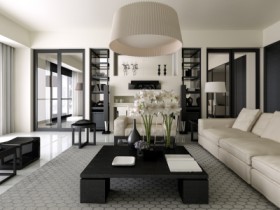Interior design is a dynamic field that continuously evolves with changing lifestyles, technological advancements and cultural influences. At Design In Vogue, we stay at the forefront of these changes, incorporating the latest trends and innovations into our projects. This blog explores the evolution of interior design, highlighting significant trends and innovations that have shaped the industry and continue to influence modern design.
Historical Overview of Interior Design
Interior design has a rich history that spans centuries. From the ornate styles of the Renaissance and Baroque periods to the minimalist approach of the modern era, interior design has undergone significant transformations.
- Renaissance and Baroque: These periods were characterized by elaborate and ornate designs, with a focus on symmetry, grandeur and opulence. Rich materials, intricate patterns and detailed craftsmanship were prominent.
- Victorian Era: The Victorian era saw a mix of styles, with a penchant for dark, heavy furnishings and rich colors. It was a period of eclecticism, where elements from different styles were combined to create a unique look.
- Modernism: The early 20th century marked the rise of modernism, characterized by clean lines, minimal ornamentation and a focus on function. This period saw the emergence of iconic designs from figures like Le Corbusier and Mies van der Rohe.
- Mid-Century Modern: The mid-20th century brought a blend of form and function, with an emphasis on simplicity organic shapes and the use of new materials like plastic and plywood. Designers like Charles and Ray Eames became influential figures during this period.
Current Trends in Interior Design
Interior design today is influenced by a myriad of factors, including technological advancements, sustainability and changing social dynamics. Here are some of the current trends that are shaping the industry:
- Biophilic Design: This trend emphasizes the connection between nature and the built environment. It involves incorporating natural elements such as plants, natural light and organic materials into the design to enhance well-being and productivity.
- Sustainability: As awareness of environmental issues grows, sustainable design practices are becoming more prevalent. This includes the use of eco-friendly materials, energy-efficient solutions and sustainable construction practices.
- Smart Homes: Technology is playing a significant role in modern interior design. Smart home systems that control lighting, heating, security and entertainment are becoming standard features in contemporary homes.
- Minimalism: The minimalist approach continues to be popular, with a focus on simplicity, clean lines and clutter-free spaces. This trend emphasizes quality over quantity and the use of multifunctional furniture.
- Maximalism: In contrast to minimalism, maximalism embraces bold colors, patterns and an eclectic mix of styles. It's about expressing personality and creating visually stimulating environments.
- Open Plan Living: Open plan layouts that combine living, dining and kitchen areas are popular for their ability to create spacious and flexible living spaces. This trend promotes social interaction and allows for versatile use of space.
- Vintage and Retro: There's a growing appreciation for vintage and retro styles, with a focus on repurposing and upcycling older pieces. This trend combines nostalgia with sustainability, creating unique and character-filled spaces.
Innovations in Interior Design
Innovations in technology and materials are driving new possibilities in interior design. Here are some of the innovations that are transforming the industry:
- 3D Printing: 3D printing technology is revolutionizing the way we create furniture and decor. It allows for custom designs and rapid prototyping, making it easier to produce unique and intricate pieces.
- Augmented Reality (AR) and Virtual Reality (VR): AR and VR technologies are enhancing the design process by allowing designers and clients to visualize spaces in 3D before they are built. This improves accuracy and helps in making informed design decisions.
- Sustainable Materials: Advances in material science are bringing new sustainable options to the market. These include materials made from recycled plastics, biodegradable composites and innovative natural materials like mycelium (fungal material).
- Smart Materials: Smart materials that can change properties based on environmental conditions are being integrated into interior design. Examples include self-healing materials, thermochromic glass and shape-memory alloys.
- Modular and Prefabricated Design: Modular and prefabricated construction methods are becoming more popular for their efficiency and sustainability. These methods allow for quicker construction times and reduced waste.
Conclusion
The evolution of interior design is a testament to the industry's ability to adapt and innovate. At Design In Vogue, we embrace these changes, incorporating the latest trends and innovations into our projects to create spaces that are both timeless and contemporary. By staying at the forefront of design evolution, we ensure that our clients benefit from the best that the industry has to offer, creating spaces that are beautiful, functional and reflective of their unique lifestyles.

